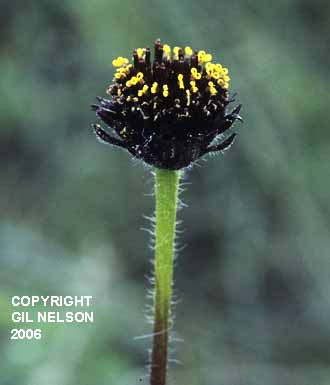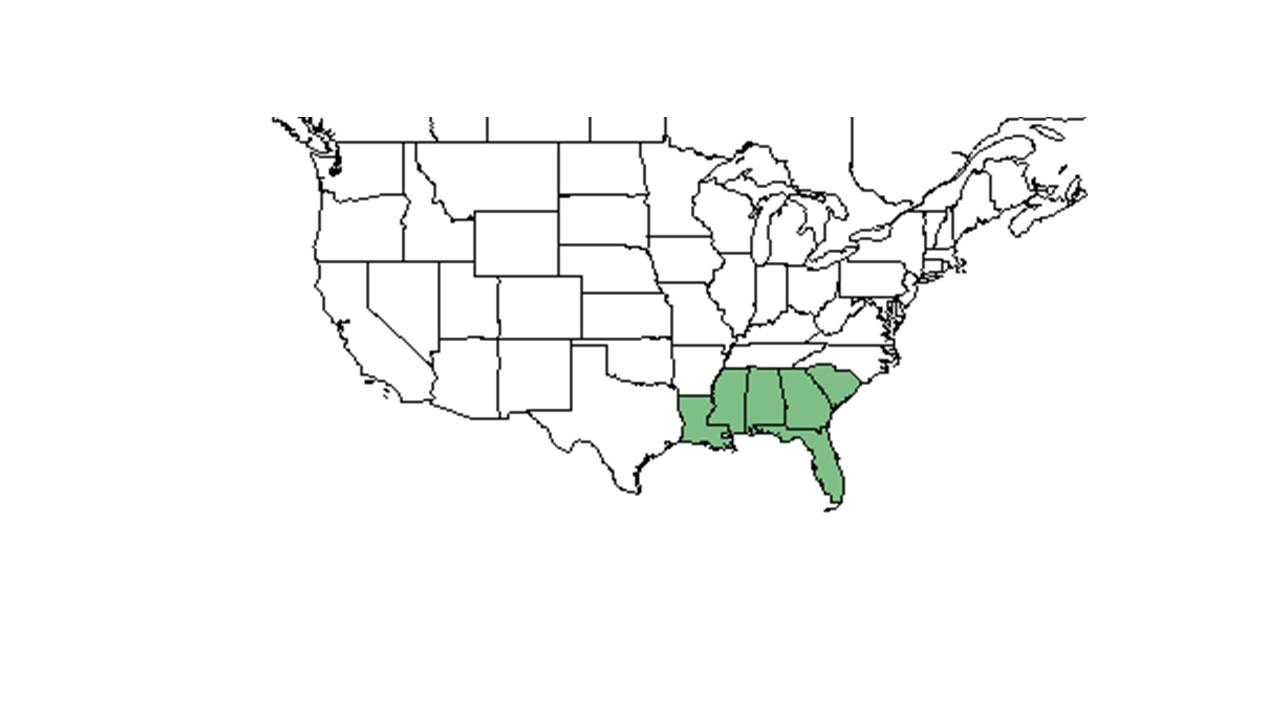Difference between revisions of "Helianthus radula"
Juliec4335 (talk | contribs) |
Emmazeitler (talk | contribs) (→Taxonomic notes) |
||
| Line 20: | Line 20: | ||
Common names: Rayless sunflower; Stiff sunflower; Roundleaf sunflower | Common names: Rayless sunflower; Stiff sunflower; Roundleaf sunflower | ||
==Taxonomic notes== | ==Taxonomic notes== | ||
| + | Synonyms: none.<ref name="weakley">Weakley, A.S. 2015. Flora of the southern and mid-atlantic states. Working Draft of 21 May 2015. University of North Carolina at Chapel Hill, Chapel Hill, North Carolina.</ref> | ||
| + | |||
| + | Varieties: none.<ref name="weakley">Weakley, A.S. 2015. Flora of the southern and mid-atlantic states. Working Draft of 21 May 2015. University of North Carolina at Chapel Hill, Chapel Hill, North Carolina.</ref> | ||
| + | |||
==Description== | ==Description== | ||
<!-- Basic life history facts such as annual/perrenial, monoecious/dioecious, root morphology, seed type, etc. --> | <!-- Basic life history facts such as annual/perrenial, monoecious/dioecious, root morphology, seed type, etc. --> | ||
Revision as of 11:41, 16 September 2020
| Helianthus radula | |
|---|---|

| |
| Photo was taken by Gil Nelson | |
| Scientific classification | |
| Kingdom: | Plantae |
| Division: | Magnoliophyta - Flowering plants |
| Class: | Magnoliopsida – Dicotyledons |
| Order: | Asterales |
| Family: | Asteraceae ⁄ Compositae |
| Genus: | Helianthus |
| Species: | H. radula |
| Binomial name | |
| Helianthus radula (Pursh) Torr. & A. Gray | |

| |
| Natural range of Helianthus radula from USDA NRCS Plants Database. | |
Common names: Rayless sunflower; Stiff sunflower; Roundleaf sunflower
Contents
Taxonomic notes
Synonyms: none.[1]
Varieties: none.[1]
Description
A description of Helianthus radula is provided in The Flora of North America.
Helianthus radula is a perennial herbaceous species. It is very distinguishable by its rosette of orbicular and nearly round leaves, which are borne basally to the ground.[2]
Distribution
Helianthus radula is found along the southeastern coastal plain from southern South Carolina south to southern peninsular Florida and west to southeastern Louisiana.[2]
Ecology
Habitat
Generally, H. radula can be found in dryish savannas and sandhills as well as dry pine flatwoods.[2] It can live in loblolly or slash pine communities,[3] upland longleaf pine communities, [4][5] pine-oak sandhill woodlands, near the edges of bogs, limestone glades, and mixed oak-cabbage palm hammocks. Additionally, it occurs in disturbed areas such as roadsides, old fields, power line corridors, by trails, and in lawn and waste areas. This species seems to prefer semi-shaded areas, and occurs on mostly wet to dry sandy soils, or over limestone.[6] As well, it is considered an indicator species of the Florida panhandle silty longleaf woodlands habitat.[7] It is very vulnerable to disturbance, which could be due to its method of seed dispersal.[8] H. radula responds negatively to soil disturbance by agriculture in Southwest Georgia.[9]
Associated species include Pinus palutris, Quercus laevis, Serenoa repens, Sabatia brevifolia, Kalmia hirsuta, Balduina uniflora, Polygala lutea, Sorghastrum secundum, Quercus pumila, Seymeria cassioides, Liatris graminifolia, Helianthus heterophyllus, Cirsium, Bigelowia, Ludwigia, Pinus elliottii, Pityopsis, Baptisia simplicifolia, Ilex glabra, Andropogon, Rynchospora, Phoebanthus tenuifolia, Eupatorium album, Pityopsis, Rhexia alifanus, Liatris gracilis, Carphephorus odoratissimus, Baptisia simplicifolia, Ctenium aromaticum, Vaccinium darrowi, Quercus pumila, Quercus minima, Gaylussacia dumosa, and Physostegia godfreyi.[6]
Helianthus radula is an indicator species for the Panhandle Silty Longleaf Woodlands community type as described in Carr et al. (2010).[10]
Phenology
This species generally flowers from late August until October.[2] Flowering and fruiting has been observed in January and August through November.[6][11]
Seed dispersal
This species is thought to be dispersed by gravity. [12]
Fire ecology
This species has been found in habitat that is burned frequently,[6] even biennially.[5]
Use by animals
The stem and leaves of this species were found to be eaten by white-tailed deer during the fall and winter.[13]
Conservation and management
Due to its restricted habitat within its small range, Helianthus radula is listed as G4 on the global scale.[14]
Cultivation and restoration
Photo Gallery
References and notes
- ↑ 1.0 1.1 Weakley, A.S. 2015. Flora of the southern and mid-atlantic states. Working Draft of 21 May 2015. University of North Carolina at Chapel Hill, Chapel Hill, North Carolina.
- ↑ 2.0 2.1 2.2 2.3 Weakley, A. S. (2015). Flora of the Southern and Mid-Atlantic States. Chapel Hill, NC, University of North Carolina Herbarium.
- ↑ Yager, L. Y., M. G. Hinderliter, et al. (2007). "Gopher tortoise response to habitat management by prescribed burning." The Journal of Wildlife Management 71: 428-434.
- ↑ Kirkman, L. K., M. B. Drew, et al. (1998). "Effects of experimental fire regimes on the population dynamics of Schwalbea americana L." Plant Ecology 137: 115-137.
- ↑ 5.0 5.1 Gilliam, F. S., W. J. Platt, et al. (2006). "Natural disturbances and the physiognomy of pine savannas: A phenomenological model." Applied Vegetation Science 9: 83-96.
- ↑ 6.0 6.1 6.2 6.3 Florida State University Robert K. Godfrey Herbarium database. URL: http://herbarium.bio.fsu.edu. Last accessed: June 2014. Collectors: Loran C. Anderson, Roomie Wilson, Delzie Demaree, C. Ritchie Bell, F. H. Sargent, Samuel B. Jones, John W. Thieret, Almut G. Jones, A. F. Clewell, R. K. Godfrey, Bruce Hansen, JoAnn Hansen, Robert L. Lazor, R. Kral, J. P. Gillespie, R. E. Perdue, Jr., Paul L. Redfearn, Jr., Kurt E. Blum, D. B. Ward, S. S. Ward, John B. Nelson, G. R. Knight, Cecil R Slaughter, Nancy E. Jordan, R. A. Norris, and R. Komarek. States and Counties: Florida: Bay, Calhoun, Citrus, Flagler, Franklin, Gadsden, Holmes, Jefferson, Lake, Leon, Levy, Liberty, Madison, Nassau, Okaloosa, Orange, Osceola, Putnam, St Johns, Taylor, Wakulla, and Walton. Georgia: Thomas. Louisiana: Tangipahoa and Washington. Mississippi: Jackson, Lamar, and Pearl River. South Carolina: Colleton.
- ↑ Carr, S. C., et al. (2010). "A Vegetation Classification of Fire-Dependent Pinelands of Florida." Castanea 75(2): 153-189.
- ↑ Kirkman, L. K., et al. (2004). "Ground Cover Recovery Patterns and Life-History Traits: Implications for Restoration Obstacles and Opportunities in a Species-Rich Savanna." Journal of Ecology 92(3): 409-421.
- ↑ Kirkman, L.K., K.L. Coffey, R.J. Mitchell, and E.B. Moser. Ground Cover Recovery Patterns and Life-History Traits: Implications for Restoration Obstacles and Opportunities in a Species-Rich Savanna. (2004). Journal of Ecology 92(3):409-421.
- ↑ Carr, S.C., K.M. Robertson, and R.K. Peet. 2010. A vegetation classification of fire-dependent pinelands of Florida. Castanea 75:153-189.
- ↑ Nelson, G. PanFlora: Plant data for the eastern United States with emphasis on the Southeastern Coastal Plains, Florida, and the Florida Panhandle. www.gilnelson.com/PanFlora/ Accessed: 12 DEC 2016
- ↑ Kirkman, L. Katherine. Unpublished database of seed dispersal mode of plants found in Coastal Plain longleaf pine-grasslands of the Jones Ecological Research Center, Georgia.
- ↑ Harlow, R. F. (1961). "Fall and winter foods of Florida white-tailed deer." The Quarterly Journal of the Florida Academy of Sciences 24(1): 19-38.
- ↑ [[1]] NatureServe Explorer. Accessed: May 22, 2019
